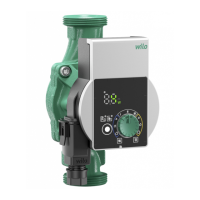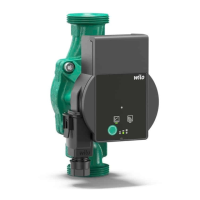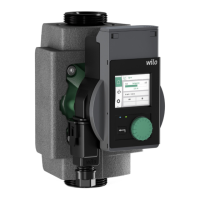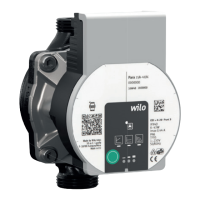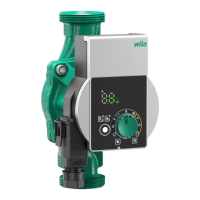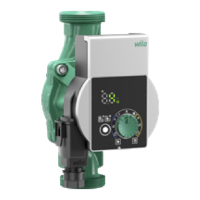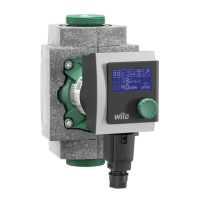Installation and operating instructions WILO Mather and Platt – Sump Pumps 20
7.
Installation
7.1 List of Essentials to made available at site
prior to installation.
Set of I-Beams of erection.
• Set of Slings, Shackles, wire ropes, eye bolts, wrenches.
• Set of spanners, Allen keys, hammer, scrapper, screw drivers.
• Skilled manpower, ladder, sufficient lighting, Helmet, Safety
jacket, Safety Shoes etc.
7.2 Location
The pump should be located to allow room for installation,
access, ventilation, maintenance and inspection with ample
headroom for lifting. Refer to the general arrangement drawing
for the pump set. If the pump is furnished with external flush
lubricated bearings, the fluid lines must be accessible from the
pump location.
Also, important, especially in the larger flow units, is proper
sump design. When more than one pump is installed and used
at the same time in the same sump, the location and spacing of
the pumps are important. Guidelines and the pump placement
as outlined in the “Hydraulics Institute Standards” are
recommended.
7.3 Part Assemblies
• Pump are shipped completely assembled except driver &
mechanical seal
• When mechanical seal is furnished, they should be installed
before the motor is put in place.
• The driver will be mounted after the pump is installed.
• When the pump shipped all the threads and all the openings are
covered. This protection should not be removed until
installation. If the pump is removed from service, this protection
should be reinstalled.
7.4 Pump Mountings
The pump may be mounted directly on the pit using the pump
mounting plate.
a) The pump was checked during assembly at the factory to
make sure the pump shaft rotated freely by hand. Handling
during shipment, storage, or preparation for installation could
have caused distortions resulting in pump shaft bending. Check
the shaft to make sure that it will rotate freely by hand.
b) Check all bolts and nuts for tightness, then carefully lower the
assembled pump into the pit, taking care not to damage lube
lines or float control equipment. Make sure that any equipment
used to lift the pump or any of its components is capable of
supporting the weights encountered. Make sure that all parts
are properly rigged before attempting to lift.
c) Pump mounting plate must maintain level from one side of
the plate to the other and be supported evenly at all points
before being bolted down.
d) If the sump doesn't provide a level mounting surface for the
pump, drive wedges under the mounting plate/pit cover until
pump levels out. The wedges must be able to support the
weight of the entire pumping assembly and hold the assembly
steady enough that no excess vibration occurs.
e) Do not bolt the discharge flange of the pump to the piping
until the baseplate foundation is completely installed.
f) Run piping to the discharge of the pump.
There should be no piping loads transmitted to the pump after
connection is made.
7.5 Driver Mounting
• Before the motor is installed, be sure to connect the motor
half coupling hub and the pump half coupling hub onto their
respective shafts.
• Carefully lift the motor and place it on the motor stool of the
pump.
• Turn the motor frame to one of the four positions where the
motor bolt holes line up to the motor stool. Select the
position of the motor to suit the desired conduit box
location. Install the motor hold down bolts. In some
instances, a motor adapter may be furnished. In this case the
adapter must be installed before the motor can be mounted.
• Motor to pump alignment is controlled by fits within the
adapter and cannot be adjusted.
• Locate the coupling and source of electrical power but DO
NOT INSTALL THE COUPLING DRIVE ELEMENT AT THIS TIME.
• Connect the motor terminals to the leads from the starter
panel. Make sure the motor shaft and/or coupling is not
touching any part of the pump shaft or pump half coupling.
Rotate the motor shaft by hand to make sure it is free to
rotate when energized.
CAUTION!
Never check driver rotation unless the pump and driver
shafts are disconnected and physically separated. Failure
to follow this instruction can result in serious damage to
the pump and driver if rotation is in the wrong direction.
• Run the motor and check for proper rotation which should be
clockwise when looking down on top of the motor. If rotation
is wrong, interchange any two motor connections on three-
phase motors. On single-phase motors, follow the motor
manufacturer’s instructions. After changing the
connections, again check the rotation to ensure that the
direction is correct.
• Disconnect and lockout the power supply to the driver.
• The coupling can now be fully installed and join the driver
and pump shafts together
• Install the coupling guarding.
• While mounting the motor & installing the coupling refer
chart on Pg. No. 18.

